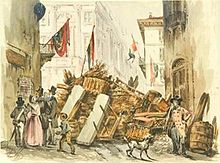Five Days of Milan
You can help expand this article with text translated from the corresponding article in French. (November 2021) Click [show] for important translation instructions.
|
| Five Days of Milan | |
|---|---|
| Part of the Lombardy–Venetia 45°28′01″N 09°11′24″E / 45.46694°N 9.19000°E(present-day Italy) | |
| Result |
Milanese revolt victorious[1]
|
Gabrio Casati
Luciano Manara
[2][3][4][5]
Ludwig von Wohlgemuth
[6][7][8][9]
armed with 600–650 firearms along with stones, bottles, clubs, pikes and swords [10][11]
including 43 women and children
600+ wounded[6]
including 5 officers
235 wounded[6]
including 4 officers
150–180 captured[13]
Provisional Government of Milan Governo provvisorio di Milano (in Italian) | |||||||||
|---|---|---|---|---|---|---|---|---|---|
| 1848–1848 | |||||||||
| Capital | Italy | 24 June 1859 | |||||||
| |||||||||
The Five Days of Milan (
Background
In 1848, the Milanese launched an
Events


Almost simultaneously with the popular uprisings of 1848 in the
The Austrian garrison at Milan was well equipped and commanded by an experienced general, Joseph Radetzky von Radetz, who despite being over 80 years old, was energetic and rigid. Radetzky had no intention of yielding to the uprising.
However, the whole city fought throughout the streets, raising barricades, firing from windows and roofs, and urging the rural population to join them. The populace was backed by the archbishop and at least 100 priests joined in the fighting against the Austrians. A bust of
Radetzky saw the difficulty of resisting under siege in the city centre, but while afraid of being attacked by the Piedmontese army and peasants from the countryside, he preferred to withdraw after losing control of the Porta Tosa (now Porta Vittoria) to the rebels. On the evening of 22 March, the Austrians withdrew towards the "Quadrilatero" (the fortified zone bounded by the four cities of Verona, Legnago, Mantua and Peschiera del Garda), 120 km eastwards, taking with them several hostages arrested at the start of the uprising. Meanwhile, the rest of Lombard and Venetic territory was free.
In memory of these days, the official newspaper of the temporary government was called simply Il 22 marzo (22 March), which began publication on 26 March at the Palazzo Marino under the direction of Carlo Tenca.[17] A monument to the uprising by the sculptor Giuseppe Grandi was built at what is now Porta Vittoria.
Almost a century later, in 1943, the uprising of Naples against WWII Nazi occupation was named The Four Days of Naples, in conscious emulation of the earlier Milan event.
See also
- Luisa Battistati
- Carlo Cattaneo
- Enrico Dandolo
- Luciano Manara
- Emilio Morosini
- Guerra regia e guerra di popolo
- Revolutions of 1848 in the Italian states
References
- ^ Grenville, John Ashley Soames (2000). Europe reshaped, 1848–1878. Oxford.
{{cite book}}: CS1 maint: location missing publisher (link) - ^ a b Stillman, William James (1898). The union of Italy, 1815–1895. Cambridge.
{{cite book}}: CS1 maint: location missing publisher (link) - ^ ISBN 9780521220774.)
{{cite book}}: CS1 maint: location missing publisher (link - ^ Maurice, Charles Edmund (1887). The revolutionary movement of 1848–9 in Italy, Austria Hungary, and Germany. New York.
{{cite book}}: CS1 maint: location missing publisher (link) - ^ American Bibliographical Center (1991). Historical abstracts: Volume 42, Issues 3–4. Santa Barbara.
{{cite book}}: CS1 maint: location missing publisher (link) - ^ a b c d Rüstow, Wilhelm (1862). Der italienische Krieg von 1848 und 1849. Zürich.
{{cite book}}: CS1 maint: location missing publisher (link) - ^ a b Whyte, Arthur James Beresford (1975). The political life and letters of Cavour, 1848–1861. Santa Barbara.
{{cite book}}: CS1 maint: location missing publisher (link) - ^ Svoboda, Johann (1870). Die Zöglinge der Wiener-Neustädter Militär-Akademie. Wien.
{{cite book}}: CS1 maint: location missing publisher (link) - ^ de Marguerittes, Julie (1859). Italy and the War of 1859. Philadelphia.
{{cite book}}: CS1 maint: location missing publisher (link) - ^ a b c d Chapman, Tim (2008). The risorgimento: Italy 1815–71. Penrith.
{{cite book}}: CS1 maint: location missing publisher (link) - ^ Stearns, Peter N. (1974). 1848: the revolutionary tide in Europe. New York.
{{cite book}}: CS1 maint: location missing publisher (link) - ^ Whittam, John (1977). Politics of the Italian Army, 1861–1918. London.
{{cite book}}: CS1 maint: location missing publisher (link) - ^ a b Wilhelm Meyer-Ott, Wilhelm Rüstow (1850). Die Kriegerischen Ereignisse in Italien in den Jahren 1848 und 1849. Zürich.
{{cite book}}: CS1 maint: location missing publisher (link) - ^ Gooch, John (1986). The unification of Italy. London.
{{cite book}}: CS1 maint: location missing publisher (link) - ^ a b Berkeley, George F.-H. (1940). Italy in the Making January 1st 1848 to November 16th 1848. Cambridge.
{{cite book}}: CS1 maint: location missing publisher (link) - ^ M. Clark, The Italian Risorgimento, Routledge 2013 p. 53.
- ISBN 9788849299229.
Bibliography
- Olivari, Stefano and Giulia Brasca (2015). Milan 360°: A metropolis to discover, among art, culture, technology and fashion. OlliService Multimedia. pp. 9–11. ISBN 9788899298050.
In Italian
- (in Italian) Piero Pieri, Storia militare del Risorgimento – volume 1 & 2, Einaudi, Torino, 1962
- (in Italian) Carlo Cattaneo, Dell'insurrezione di Milano nel 1848 e della successiva guerra, e-text Liber liber/Progetto Manuzio
- (in Italian) Antonio Scurati, Una storia romantica, romanzo Bompiani, 2007
- (in Italian) ISBN 978-88-95849-14-0. Testi di Aldo A. Mola, Giancarlo Lacchin, Roberto Lauro, Maurizio Griffo, Agostino Giovagnoli, Cecilia Dau Novelli, Romano Bracalini, Carlo Cattaneo, Gianni Oliva, Emanuele Bettini, Matteo Sanfilippo, Giuseppe Poletta, Franco Della Peruta, Fulvio Peirone, Gabriella Bonacchi, Anna Maria Isastia, Elena Fontanella, Andrea Vento, Vittorio Nichilo, Giorgio Cosmacini, Roberto Guerri, Lucia Romaniello, Giuseppe Garibaldi, Gian Paolo Caprettini, Gian Mario Benzing, Roberto Cassanelli.
